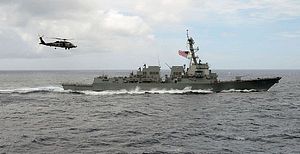A U.S. Arleigh Burke-class destroyer had an “unsafe” and “unprofessional” interaction with a Chinese warship during a Freedom of Navigation Operation (FONOP) in the South China Sea on Sunday.
On September 30 the USS Decatur reportedly performed FONOPs near the Chinese-occupied Gaven and Johnson Reefs in the South China Sea’s contested Spratly Islands. The next day, U.S. officials told CNN that there was an “unsafe” incident with a Chinese warship during the operation, which closed within 45 yards of the U.S. ship.
A Pacific Fleet spokesman later elaborated that a People’s Liberation Army Navy (PLAN) Luyang destroyer approached the USS Decatur near Gaven Reef, conducting increasingly aggressive maneuvers and warning the U.S. ship to depart the area, and finally closing within 45 yards of Decatur’s bow, forcing it to maneuver to avoid a collision.
There are three distinct classes of PLAN destroyers called Luyangs that all share a common hull form. It isn’t clear from the spokesman’s statement whether the ship that approached the Decatur was an older type or one of the newer classes that share similar capabilities to the U.S. Arleigh Burkes, but all the Luyangs are roughly the same length and width as the Decatur, with a somewhat smaller displacement.
U.S. warships often maneuver in close formation, but their movements are closely coordinated, following standardized and procedures and principles, and the maneuvering ships rarely have less than 1,000 yards between them.
Forty-five yards is even closer than U.S. warships try to keep during underway replenishments with a supply ship to receive stores or fuel at-sea, where the optimal separation is between 150 and 180 feet. But at-sea replenishments are highly choreographed, with both ships in constant communication, traveling along a predetermined course at predetermined speeds to safely operate in close proximity.
The Decatur’s FONOP reportedly exercised the right of innocent passage, which permits vessels to transit through another state’s territorial waters, generally defined as within 12 nautical miles from a sovereign coastline. The UN Law of the Sea requires that innocent passage be “continuous and expeditious.” That doesn’t mean that an innocent passage transit must be in a straight line, but it does preclude gratuitous maneuvers and unrelated activities that do not have direct bearing on completing the passage itself.
This means that Decatur was likely maintaining a steady course when the Chinese warship approached it in an attempt to force it off-course and induce it to leave.
The Luyang’s maneuver against the Decatur is similar to a 2013 act of coercion against a U.S. cruiser in the South China Sea. In that incident, the USS Cowpens was cut off by a Chinese warship across its bow at approximately 500 yards, and the U.S. ship stopped its engines to prevent a potential collision.
Sunday’s incident took place at a tenth that range, making it one of the most dangerous incidents between U.S. and Chinese warships since tensions began building in the South China Sea.
China often acts assertively against foreign warships in proximity to the South China Sea islands it occupies. Earlier in September, the British warship HMS Albion asserted freedom of navigation rights near the Paracel Islands and was reportedly shadowed by a Chinese warship at about 200 yards and buzzed by aircraft.
In 2015 the United States and China concluded a series of agreements to prevent dangerous military behaviors for both ships and aircraft. Contrasted with a similar Cold War-era agreement with the Soviet Union to prevent serious incidents at sea, the United States’ agreements with China are weakened by noncompulsory language that leaves ample discretion to sidestep the accord’s intent. Since then, China has engaged in numerous unsafe incidents against U.S. surveillance planes, while generally downplaying the danger they posed afterwards. Sunday’s incident may signal a new willingness to employ similarly aggressive tactics against U.S. warships in the South China Sea.

































